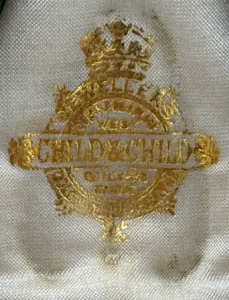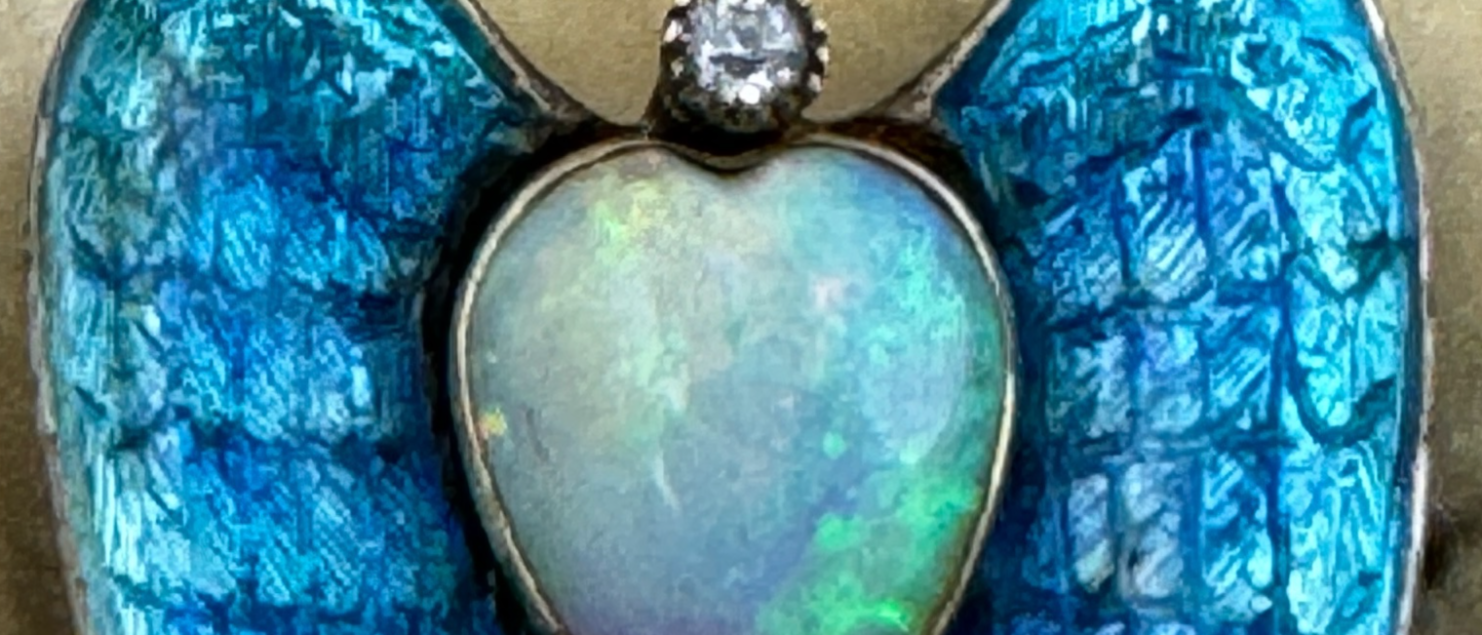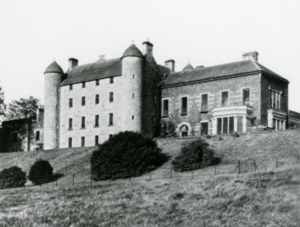An exceptional jewel by Child and Child | Fine & Decorative Interiors including Jewellery & Collectables: 9th July 2024
Methven Castle, completed in 1680, with its later added east and west wings | Image: James Valentine Photographic Collection / University of St Andrews Library
This late Victorian winged-heart brooch-pendant, with blue guilloché enamel angel wings flanking a cabochon opal heart, pink topaz heart drop and diamond accent surmount was created by Child and Child – probably one of the most artistic of jewellers working in London during the Edwardian era. It was formerly in the collection of Barbara Smythe from whom it passed to the current owner, one of Barbara’s relatives.
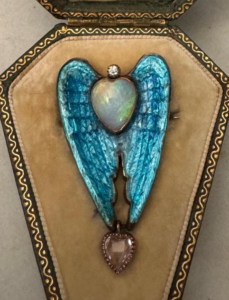
The brooch-pendant within its original fitted Child and Child case
Barbara Smythe was born in 1899 at Methven Castle – the surrounding area and the castle, located just over six miles west of Perth, both have a long and distinguished history. In 1503 as part of her marriage gift, and with a nod to the politics of the era, Methven Castle was given to Margaret Tudor (1489-1541), daughter of Henry VII and queen of James IV, King of Scots. Margaret lived at the castle following her third marriage to Henry Stewart, 1st Lord Methven, in 1528. The third Lord Methven died without an heir in 1584 and King James VI gave Methven Castle to his favourite, the Duke of Lennox. Eighty years later the estate was purchased by Patrick Smythe of Braco, following the sale of his estates in the Orkneys; the castle as it looks today dates from this period when designed and built by the architect and Master Mason to the Crown of Scotland, John Mylne. The Smythe family owned the castle through the 18th and 19th centuries but in 1923 it was sold, and subsequently passed through a number of hands until it was bought in 1984 by the architect Kenneth Murdoch. Murdoch undertook extensive restoration work on Methven, as part of this the east wing was demolished, following the earlier removal of the west wing in 1950s, and the castle was returned to its 17th century form.
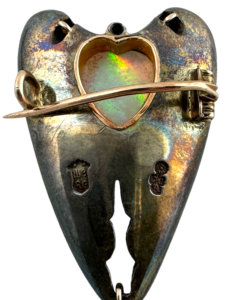
The reverse of the brooch-pendant, with Child and Child marks of C&C with sunflower, and WC/HC mark for Walter and Harold Child
Walter (1840-1930) and Harold Child (1848-1915) founded their jewellery business in Seville Street, Knightsbridge, in 1880, and in February 1888 they registered their mark at the Worshipful Company of Goldsmiths, when the brothers were recorded as plate workers. In 1891 the business moved to Alfred Place West, now Thurloe Street, South Kensington, and at around this time the focus shifted to creating jewellery although they continued to make and sell domestic silver. Child and Child followed in the footsteps of Carlo Giuliano (1831-1895), working in the Neo-Classical taste with enamelled jewels. Their Revivalist style attracted London’s turn of the century community of artists, one of whom was Sir Edward Burne-Jones who became an important client and also commissioned pieces to his own designs. His silver ring, made by Child and Child, was set with a heart-shaped baroque pearl and he wore it on the little finger of his left hand, he was particularly attracted to the motif of the heart and also ordered a pair of silver-mounted, green-stained ivory cufflinks for himself.
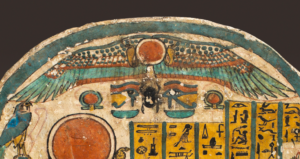
Detail from a Stela of Saiah, circa 825-712 BC, one of four stelae found near the doorway of the brick chapel of the family of Saiah, a wab, or purification priest of Amun (sun, the king of the gods); the winged sun disk here sits above two eyes of Horus and two shen rings, symbols of eternity | Image: Metropolitan Museum of Art, New York
Child and Child jewels were invariably fashioned in the shape of wings, either closed or open, often in silver, engraved to simulate feathers and overlaid with translucent blue or green enamel. The closed wings of the brooch at auction this July are highly evocative of those of the enigmatic kingfisher, but the source for the design is likely to be Egyptian, even though the mood is overwhelmingly romantic. Egyptomania, the craze for ancient Egypt, has peppered Western history for many centuries and was certainly nothing new at the time Child and Child were in business. At the very end of the 18th century renewed interest in all things Egyptian had been generated following the discovery of the Rosetta stone by Napoleon’s soldiers in 1799. In 1801 the stone was surrendered to Britain following the defeat of the French at the Battle of the Nile, and at the British Museum the study of its scripts and languages was instrumental in the decipherment of hieroglyphics. The Egypt aesthetic continued to be a force throughout the 19th century, and in 1873 Christopher Dresser published Principles of Decorative Design, featuring styles and schemes aimed at designers, one such design was of the Egyptian winged globe. In antiquity the device was seen on the lintels of doors and windows in the belief that nothing evil could pass beneath it. In the 19th century this protective force was channelled through winged jewels, in the form of globes, hearts and pearls – Child and Child used the theme systematically in a series of their jewels. Interestingly, in 1894 Edward Burne-Jones had used the winged globe in his crest when he received his baronetcy.
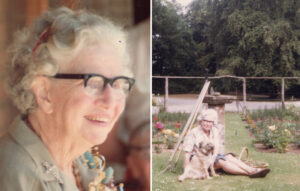
Left: Barbara at a family gathering; her family note that she was seldom seen without a brooch | Right: Barbara and her dog Bunty in the garden of Moulinalmond, the Smythe family home / Both images: Courtesy a family member
We don’t know when or why Barbara acquired the winged-heart brooch – in the year of her birth, 1899, Child and Child’s partnership was dissolved, although Harold continued in business until his death in Milan in 1915. But we do have some intriguing insights into Barbara’s character and interests as well as the activities of her family. She was the only daughter of Colonel David Smythe of Methven (1850-1928) and the Hon. Katharine Bagot (1859-1952), and they had married in London in 1898. Colonel Smythe served in the Cameron Highlanders and during the Zulu War, 1878-79, and he commanded the 3rd Battalion of the Black Watch until 1897. His brother Charles (1852-1918) travelled to the gold fields of South Africa in 1871 but was to return home without much luck in 1873. A year later he was back in South Africa, he leased a farm in Pietermaritzburg and got married in 1876. In 1883 he went into politics and rose to become Premier and Colonial Secretary of Natal in 1906.
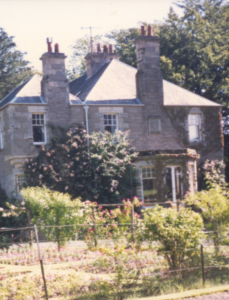
The exterior of Moulinalmond | Image: Courtesy a family member
Barbara’s driving passion was nature, and she was highly knowledgeable and passionate about gardening and plants. The gardens at Methven Castle are reputed to have hosted Scotland’s first pinetum, although many of the trees from it have been lost. Sadly, there are no documented designers of the gardens nor formal records of their development over the years, however, it is clear that they were nurtured and treasured by successive generations of the Smythe family. Methven Wood is designated as a Site of Special Scientific Interest by Historic Environment Scotland. The vendor of our brooch recalls the wonderful stories Barbara wrote for the children of the family, (their pets included), notably The Bracken Elves of Methven Woods, in which their collaborative adventures with eight children, ten dogs and two cats regaled their young audience. The Bracken Elves were supportive albeit magical characters and so real were they that the youngsters left sweets for them at the Elves’ Oak in the Wood; Barbara made sure the sweets duly disappeared in order to keep the magic alive. In 1931 Barbara presented prizes in the Annual Children’s Essay Competition, under the auspices of the Perthshire Society of Natural Sciences, she took the opportunity to comment that despite the current period of turmoil and unrest many people were known to come together through a love of nature, furthermore she said that it could not be stressed too much how great it was that ‘lads and lasses should be brought into contact with nature’. Earlier, Barbara was one of a number of Scottish young ladies who formed a group known as The Cavalier Club, they produced a handmade magazine, The Cavalier, (Barbara was the Editor) which was circulated in exchange for donations to the War effort. The 1916 double Christmas issue of The Cavalier is held in the archives of Edinburgh University, it features short stories, poems, illustrations and watercolours, along with a Christmas card titled Christmas Leave in which a young man in naval uniform sits by the fireside surrounded by children.
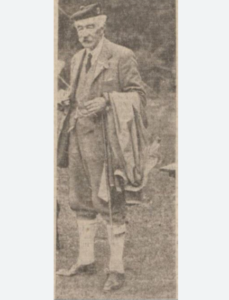
Colonel David Murray Smythe (1850-1928), Barbara’s father. The photograph of the Colonel was published alongside his obituary in the Dundee Courier, 11 February 1928
Barbara herself did not have children and did not marry, but she is remembered for being incredibly warm-hearted and welcoming to the younger members of her family, always supportive and a key champion during times of adversity. We would like to think that Child and Child had someone very special in mind, perhaps a guardian angel, when they created this remarkable brooch.
